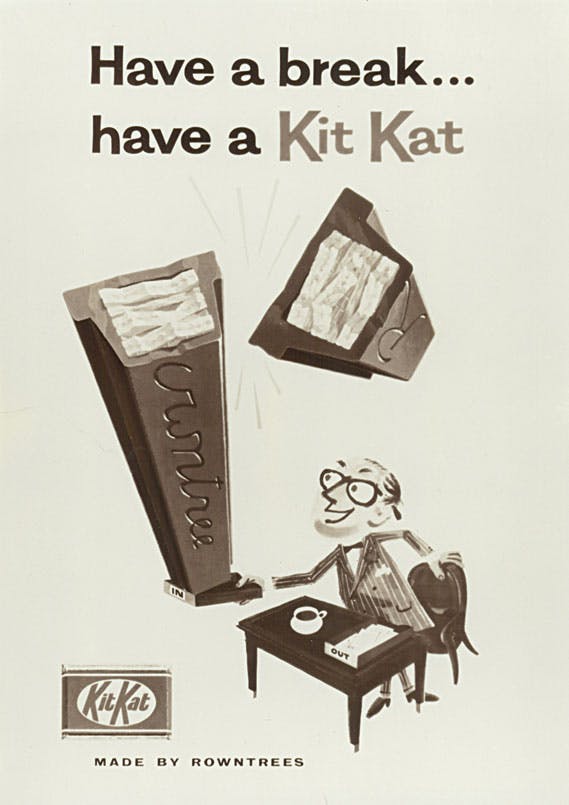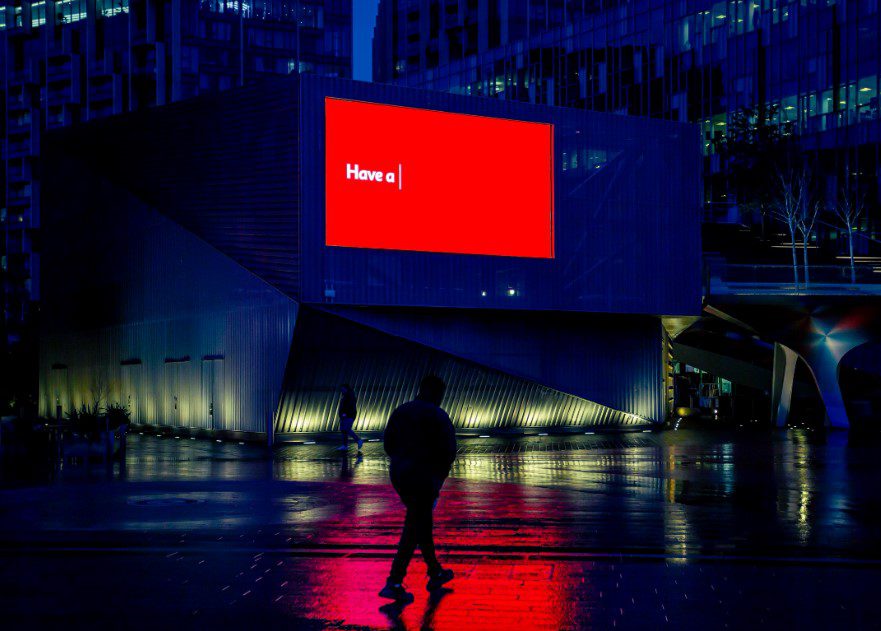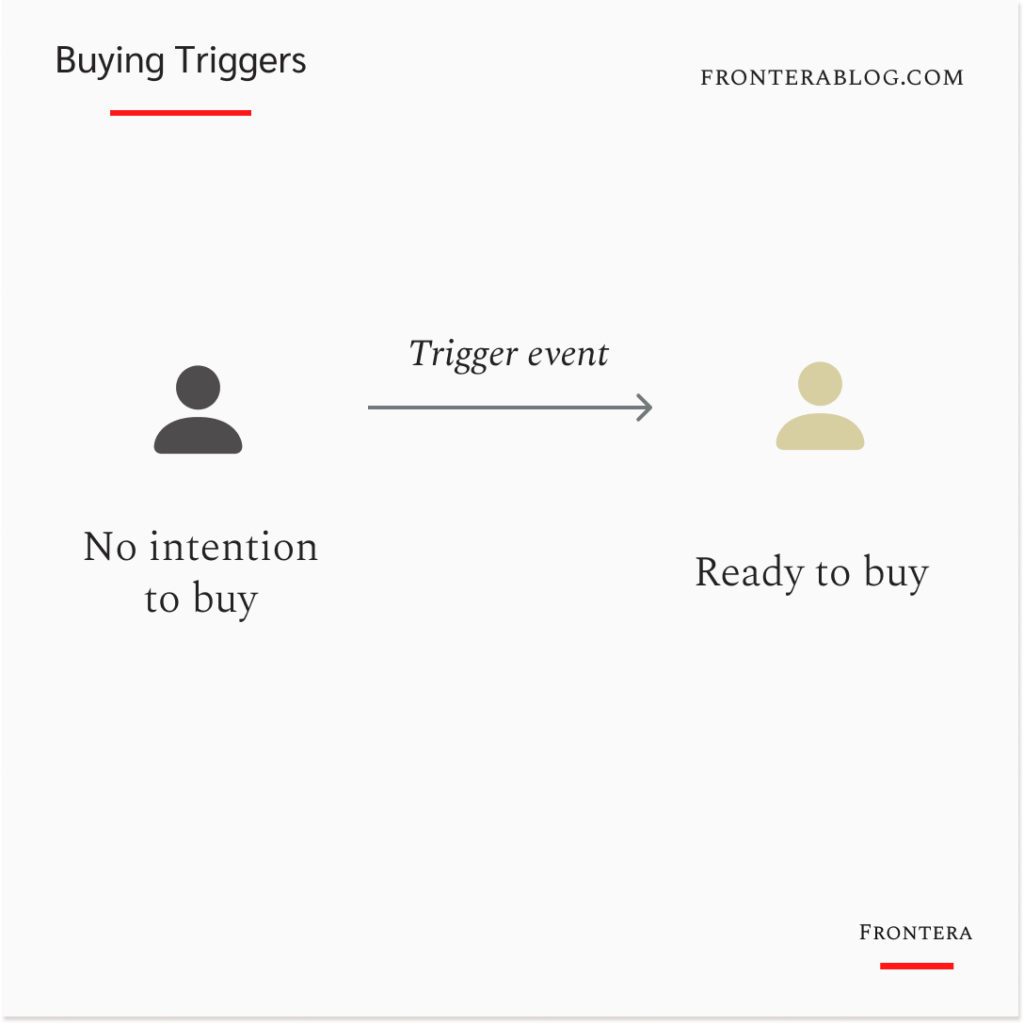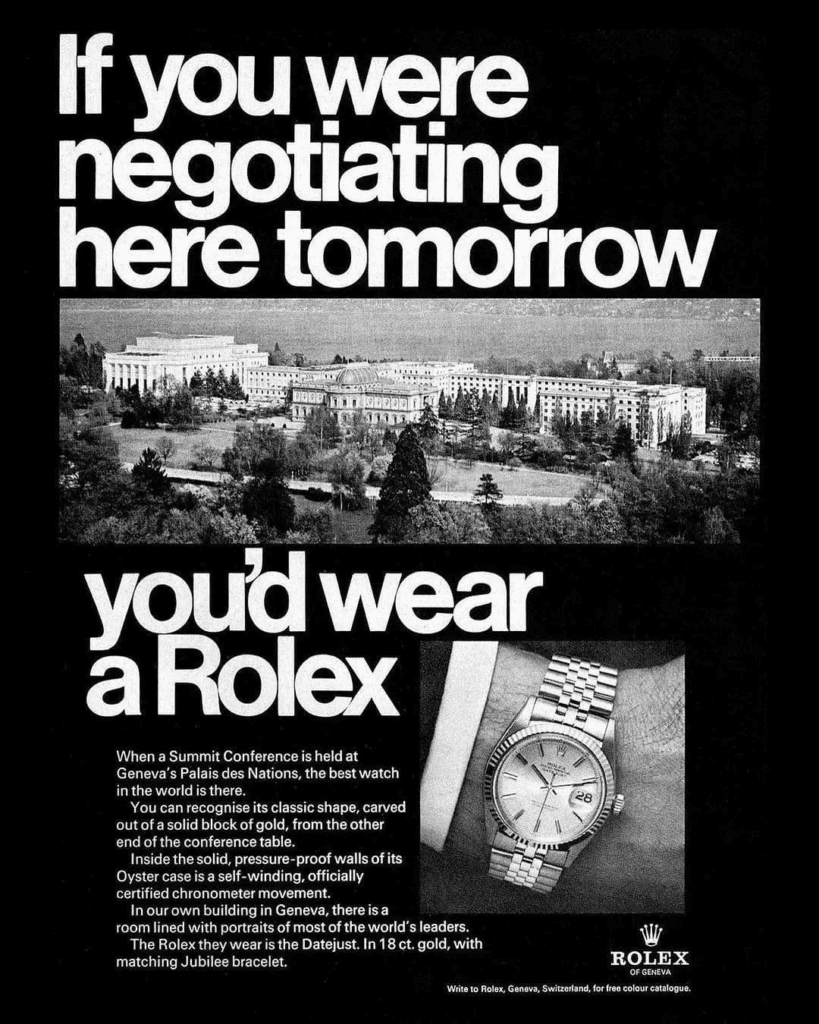In 1957, copywriter Donald Gilles got a challenge.
“How can we position this chocolate brand called KitKat?”
The UK economy was finally booming after World War II.
So KitKat’s owner Rowntree’s knocked on advertising agency JWT’s door for a new campaign.
And JWT assigned Gilles to the task.
Now, the positioning challenge for a bar of chocolate is similar to the one Unilever had with Dove.
It’s a commodity.
You can talk about how good it tastes or melts in the mouth.
But in the end, it’s one of many chocolate bars on a shelf.
And they all do the same.
So instead of thinking about a chocolate’s attributes, Gilles decided to look for another way to position it.
He decided to research KitKat’s history.
And after weeks of reading and meetings, he found something he could use.
Rowntree’s created KitKat’s unique four-finger bar after the idea of making the chocolate bars smaller.
So “a man could take to work in his pack.”
Gilles realized the best moment for a worker to eat a KitKat would be a break.
After all, every employee had breaks from work.
And they had to do something during those breaks.
This gave him the big idea.
KitKat was not going to be about the taste or flavor like other chocolate brands.
But how it was going to be the perfect snack for those breaks.
Gilles came up with a catchy slogan for his idea:
“Have a break, have a KitKat.”

Result?
The campaign became a big hit.
It became the most important milestone that turned KitKat into a brand known worldwide.
“Have a break, have a KitKat” became the slogan of the company.
The slogan became so powerful, KitKat even made ads without using their logo and writing it fully.
But people still knew that it was from KitKat.

When “a situation” triggers buying
The genius in the campaign was this.
Everybody had breaks at work.
So there was a trigger that put people in a specific situation.
And that trigger made them ready to take action.
Gilles associated KitKat with that trigger — breaks at work.
When the buying trigger occurred, the result was eating a KitKat.
Think about it.
We have many obvious buying triggers in our lives.
Like becoming a parent.
Your life changes the moment you know you’ll become a parent.
You start looking for parenting books, furniture for the baby’s room, and maybe even look for a bigger house.
So the buying trigger occurs.
And you are willing to pay for dozens of new things the next day.
But here’s the thing.
Not all buying triggers are as obvious as becoming a parent or upcoming Valentine’s Day.
It can be a department head losing the third contract to a competitor because of price.
Or the moment a business owner decides to expand.
Just like becoming a parent, these triggers make them willing to look (and pay) for solutions they’ve never considered before.

Now comes the fun part.
How can you use buying triggers for your brand?
Two ways to use buying triggers to create growth:
1. Find the context
Remember the Jobs-to-be-done framework?
McDonald’s increased sales by 400% after understanding the context of milkshake buyers.
They were driving to work.
And they needed something to keep themselves entertained during the journey which also kept them full for a few hours.
McDonald’s couldn’t increase sales with new flavors or low calories.
But they did it by making the milkshake last longer and focusing their campaigns around that.
Demographics and focus groups didn’t matter.
The breakthrough came after they figured out the context.
Understanding the context enables two things.
First, you can truly improve your product or service.
Because you know customers’ situation and what would matter in that context.
Second, it makes your marketing much more effective.
People can see you understand their situation well.
You can directly talk to their soul with your sales presentations, website copy, or ads.
So think beyond demographics.
Try to understand your customers’ context.
Asking your customers this question might give you unexpected insights:
“When did you first start looking for a solution to this? What was the trigger?”
2. Claim a non-obvious buying trigger
Rolex had a sentence on their website a few years ago.
It said:
“Whether it is an heirloom, a milestone of success, or a gift, a Rolex watch frequently becomes an emotional symbol that brings life exceptional moments.”
Did you notice?
They mention three buying triggers — which proves they know what they are doing.
But let’s focus on “a milestone of success” for a second.
Because this is a non-obvious buying trigger.
It’s the moment after a big deal, a promotion, or a successful exit.
The moment of “I made it.”
Just like KitKat and work breaks, Rolex identified this non-obvious trigger and claimed it for decades.
And guess what happened?
Owning a Rolex became synonymous with “I made it.”
So people started buying Rolex as an emotional symbol after big achievements.

Steve Jobs has a quote I like:
“Everything around you that you call life was made up by people that were no smarter than you.
And you can change it, you can influence it, you can build your own things that other people can use.”
He was right.
It’s funny how most things we accept without thinking (like buying a Rolex after an achievement) are a result of other people’s designs.
The strategy behind some brands fills the moments in people’s lives.
And make those brands what they are today.
Some others are not so good at it.
We talked about watches.
The buying trigger for watches was knowing the time to organize your life for decades.
But most watch brands suffered when “knowing the time” stopped being the main buying trigger.
So only the ones that focused on other buying triggers —like Rolex— survived.
Moral of the story?
Some brands serve for obvious buying triggers.
Like TurboTax and tax season.
They are easy to understand.
But if your product or service doesn’t have an obvious trigger — look for a non-obvious one.
It can be the moment a project (or its budget) gets approved within a company.
Or a security breach and the fear of getting into trouble because of it.
Or somebody receiving a big amount of money due to inheritance/retirement and not knowing what to do with it.
So look for non-obvious buying triggers.
Remember.
Context can be a great way to differentiate.
–
Enjoyed this article?
Then you’ll love the How Brands Win Newsletter.
Get the “5 Mental Models to Differentiate Your Business” guide when you join. It’s free.
